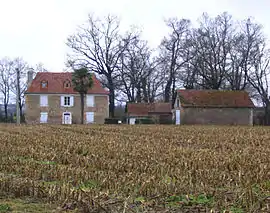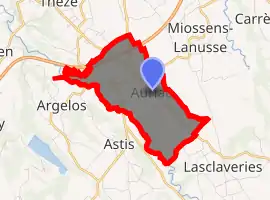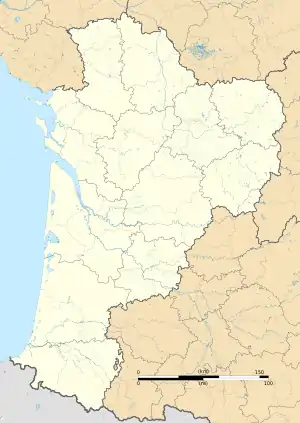Auriac, Pyrénées-Atlantiques
Auriac (French pronunciation: [oʁjak] (![]() listen)) is a commune in the Pyrénées-Atlantiques department in the Nouvelle-Aquitaine region of south-western France.
listen)) is a commune in the Pyrénées-Atlantiques department in the Nouvelle-Aquitaine region of south-western France.
Auriac | |
|---|---|
 Bearnais house in Auriac | |
Location of Auriac 
| |
 Auriac  Auriac | |
| Coordinates: 43°27′23″N 0°18′53″W | |
| Country | France |
| Region | Nouvelle-Aquitaine |
| Department | Pyrénées-Atlantiques |
| Arrondissement | Pau |
| Canton | Terres des Luys et Coteaux du Vic-Bilh |
| Intercommunality | CC Luys Béarn |
| Government | |
| • Mayor (2020–2026) | Jean-Claude Vignes |
| Area 1 | 5.23 km2 (2.02 sq mi) |
| Population (2017-01-01)[1] | 238 |
| • Density | 46/km2 (120/sq mi) |
| Time zone | UTC+01:00 (CET) |
| • Summer (DST) | UTC+02:00 (CEST) |
| INSEE/Postal code | 64078 /64450 |
| Elevation | 145–250 m (476–820 ft) (avg. 242 m or 794 ft) |
| 1 French Land Register data, which excludes lakes, ponds, glaciers > 1 km2 (0.386 sq mi or 247 acres) and river estuaries. | |
The inhabitants of the commune are known as Auriacois or Auriacoises.[2]
Geography
Auriac is located some 20 km north of Pau just east of Argelos. Access to the commune is by road D834 from Sarron in the north which passes through the commune and continues to Pau in the south. Access to the village is by road D944 from the village to Thèze in the north-west and the D227 from the village to Sévignacq in the south-east. The A55 autoroute passes through the north of the commune with Exit 9 just north-east of the commune giving access to road D834. The commune is mixed forest and farmland.[3]
Places and hamlets
Neighbouring communes and villages
Toponymy
.JPG.webp)
.JPG.webp)
The commune name in béarnais is Auriac. Michel Grosclaude said that the name probably comes from the Latin man's name Aurius with the Gallo-Roman suffix -acum giving "Domain of Aurius".[7]
The following table shows the origin of the commune name:
| Name | Spelling | Date | Source | Page | Origin | Description |
|---|---|---|---|---|---|---|
| Auriac | Auriag | 1096 | Raymond | Marka | Village | |
| Auriac | 1750 | Cassini |
Sources:
- Raymond: Topographic Dictionary of the Department of Basses-Pyrenees, 1863, on the page numbers indicated in the table. (in French)[8]
- Grosclaude: Toponymic Dictionary of communes, Béarn, 2006 (in French)[7]
- Cassini: Cassini Map from 1750[9]
Origins:
- Marca: Pierre de Marca, History of Béarn.[10]
History
Paul Raymond noted that Auriac was once an annex of Argelos.[8]
Administration
List of Successive Mayors[11]
| From | To | Name | |
|---|---|---|---|
| 1824 | 1829 | Augustin Baix | |
| 1829 | 1831 | Jean Bertrand | |
| 1831 | 1836 | Augustin Baix | |
| 1836 | 1837 | Pierre Madaune | |
| 1837 | 1864 | Pierre Julien Viguerie | |
| 1864 | 1899 | Justin Madaune | |
| 1899 | 1908 | Jean Philippe Madaune | |
| 1908 | 1911 | Maurice Rey | |
| 1911 | 1919 | André Madaune | |
| 1919 | 1929 | Jean Soubré | |
| 1929 | 1939 | André Madaune | |
| 1939 | 1940 | Jean Touret |
.JPG.webp)
.JPG.webp)
- Mayors from 1940
| From | To | Name | Party | Position |
|---|---|---|---|---|
| 1940 | 1942 | Jean Evrard | ||
| 1942 | 1944 | Pierre Boué-Cam | ||
| 1944 | 1945 | Joseph Soubré | ||
| 1945 | 1948 | René Rey | ||
| 1948 | 1949 | Pierre Clauzet | ||
| 1949 | 1951 | Jean Maribat | ||
| 1951 | 1951 | Joseph Soubré | ||
| 1951 | 1953 | Pierre Boué-Cam | ||
| 1953 | 1959 | René Rey | ||
| 1959 | 1962 | Pierre Clauzet | ||
| 1962 | 1963 | René Rey | ||
| 1965 | 1971 | Claude Larrieu | ||
| 1971 | 1977 | Henri Hélip | ||
| 1977 | 1993 | Marc Rey | ||
| 1993 | 2020 | Christian Larrouturou |
(Not all data is known)
Inter-communality
The commune is part of five inter-communal structures:
- the Communauté de communes des Luys en Béarn;
- the SIVU for collective sanitation Auriac-Miossens-Lanusse-Thèze
- the Energy association of Pyrénées-Atlantiques;
- the inter-communal association for the management of drinking water from the Luy-Gabas-Lées;
- the inter-communal association of Garlède-Lalonquette;
Demography
In 2017 the commune had 238 inhabitants.
|
| ||||||||||||||||||||||||||||||||||||||||||||||||||||||||||||||||||||||||||||||||||||||||||||||||||||||
| Source: EHESS[12] and INSEE[13] | |||||||||||||||||||||||||||||||||||||||||||||||||||||||||||||||||||||||||||||||||||||||||||||||||||||||
Culture and heritage
.JPG.webp)
Civil heritage
The commune has a number of buildings and structures that are registered as historical monuments:
Religious heritage
.JPG.webp)
The commune has two religious buildings that are registered as historical monuments:
- The Parish Church of Saint-François-de-Sales (18th century) (destroyed)
 [15]
[15] - The Parish Church of Saint-François-de-Sales (1885).
 [16] This church was built in 1885 to replace the old church of the same name which appeared on the Cassini Map. The Church contains many items that are registered as historical objects:
[16] This church was built in 1885 to replace the old church of the same name which appeared on the Cassini Map. The Church contains many items that are registered as historical objects:
- The furniture of the church
 [17]
[17] - A Chasuble (18th century)
 [18]
[18] - A Sun-ray Monstrance (19th century)
 [19]
[19] - 2 Altar Candlesticks (19th century)
 [20]
[20] - A Chalice (19th century)
 [21]
[21] - A Prie-dieu (19th century)
 [22]
[22] - A Stoup (19th century)
 [23]
[23] - 2 Altars, 4 altar seatings, and 2 Tabernacles (1885)
 [24]
[24] - An Altar, 2 altar seatings, a Tabernacle, and 2 Statues (1885)
 [25]
[25] - 3 Stained glass windows of people: Saint Francis de Sales, Saint Michael protecting a canon, and Saint John (1887)
 [26]
[26]
- The furniture of the church
Facilities
Auriac has a primary school which also serves the communes of Garlède-Mondebat, Lalonquette et Miossens-Lanusse in an Educational Inter-communal Grouping.
See also
External links
- Community of communes of Luys en Béarn website (in French)
- Auriac on Lion1906
- Auriac on Géoportail, National Geographic Institute (IGN) website (in French)
- Auriac on the 1750 Cassini Map
References
- "Populations légales 2017". INSEE. Retrieved 6 January 2020.
- Inhabitants of Pyrénées-Atlantiques (in French)
- Google Maps
- Ministry of Culture, Mérimée IA00026731 House at Cazaudehore (in French)
- Ministry of Culture, Mérimée IA00026732 House at Porte (in French)
- Géoportail, IGN (in French)
- Michel Grosclaude, Toponymic Dictionary of communes, Béarn, Edicions reclams & Édition Cairn - 2006, 416 pages, ISBN 2-35068-005-3 (in French)
- Topographic Dictionary of the Department of Basses-Pyrenees, p. 17, Paul Raymond, Imprimerie nationale, 1863, Digitised from Lyon Public Library 15 June 2011 (in French)
- Cassini Map 1750 - Auriac
- Pierre de Marca, History of Béarn p. 356
- List of Mayors of France (in French)
- Données Cassini, EHESS
- Population en historique depuis 1968, INSEE
- Ministry of Culture, Mérimée IA00026729 Houses and Farms (in French)
- Ministry of Culture, Mérimée IA00027931 Church of Saint-François-de-Sales (destroyed) (in French)
- Ministry of Culture, Mérimée IA00027930 Church of Saint-François-de-Sales (in French)
- Ministry of Culture, Palissy IM64001186 Furniture in the Church (in French)
- Ministry of Culture, Palissy IM64001185 Chasuble (in French)
- Ministry of Culture, Palissy IM64001184 Sun-ray Monstrance (in French)
- Ministry of Culture, Palissy IM64001183 2 Altar Candlesticks (in French)
- Ministry of Culture, Palissy IM64001182 Chalice (in French)
- Ministry of Culture, Palissy IM64001181 Prie-dieux (in French)
- Ministry of Culture, Palissy IM64001180 Stoup (in French)
- Ministry of Culture, Palissy IM64001179 2 Altars, 4 altar seatings, and 2 Tabernacles (in French)
- Ministry of Culture, Palissy IM64001178 Altar, 2 altar seatings, a Tabernacle, and 2 Statues (in French)
- Ministry of Culture, Palissy IM64001177 3 Stained glass windows of people: Saint Francis de Sales, Saint Michael protecting a canon, and Saint John (in French)
| Wikimedia Commons has media related to Auriac (Pyrénées-Atlantiques). |